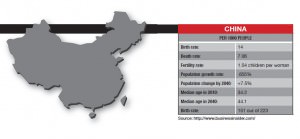An Aging World = Social and Economic Timebomb
China began in its single child policy in 1979, as a result of the government’s desire to curb problems related to overpopulation. Because of this policy, China’s population is estimated to be about 400 million less than what it would have been otherwise.
That single child policy may come back to bite China’s politicians. Single children are now faced with the prospect of supporting two parents and up to four grandparents. As soon as 2020, the working age population will peak, and in 2050 the over-60 population of China will be larger than the entire population of America.
Deeper than Cheap
China’s competitive advantage has always been its ample supply of relatively cheap labour, which has fueled its explosive economic growth. However, that advantage is fleeting because of two reasons. First, China’s working-age population is quickly approaching its peak. Second, the government is implementing policy to rebalance the economy through increasing wages and the consumption factor of its GDP.
 With recent events like the Foxconn suicides (at Apple Inc.’s Chinese manufacturing plant) undergoing media scrutiny, wages as well as working conditions are being given a necessary facelift. Governments and companies are also under more pressure from Chinese workers (particularly the exploited migratory workers) who are taking part in very large and frequent protests (upwards of 300,000 protests in 2005 alone).
With recent events like the Foxconn suicides (at Apple Inc.’s Chinese manufacturing plant) undergoing media scrutiny, wages as well as working conditions are being given a necessary facelift. Governments and companies are also under more pressure from Chinese workers (particularly the exploited migratory workers) who are taking part in very large and frequent protests (upwards of 300,000 protests in 2005 alone).
Places like Guangdong, for instance, have seen pay increases of 24 to 32% since a massive Honda strike was held.
In short, China cannot sustain its competitive advantage of cheap labour for much longer. Furthermore, this does not even consider the population decline that will begin in 2035, resulting in massive changes to the labour market.
Despite the negative connotation of rising wages to businesses, Lee Li, associate professor of marketing at York University, argues that China will continue to maintain a competitive advantage. Simply speaking, “It’s not just about cost,” and that China’s advantage is deeper than most people think. The notion that Chinese firms are content with worker exploitation as their bread and butter strategy is a gross simplification.
Why is it that low-cost locations like Vietnam and Bangladesh have not achieved a similar industrial cost advantage as China?
Professor Li says the separating factor is that China has a combination of skillful labour, infrastructure, communication systems and banking systems. Therefore, larger and more sophisticated companies (e.g. technology companies) that rely on these systems and need skilled workers will likely continue their operations in China. Smaller companies and those in less sophisticated industries such as textiles will find it easier and more cost-effective to move away.
China’s other advantage over countries like Bangladesh is in “cluster-related” factors. Cluster-related samples, Li says, are simply the surrounding businesses and members of a geographical cluster which accrue benefits to a business. For example, a nearby adhesive-making factory would be very beneficial to a business that uses the adhesive to create end products.
[pullquote]… China cannot sustain its competitive advantage of cheap labour for much longer.[/pullquote]
On the issue of pensions, China’s health insurance coverage for all but the affluent is particularly worrying. We as Canadians take for granted the fallback that the government provides us when we are ill.
In China, millions of retired persons have only their single offspring as their source of post-retirement income. In the rural areas where over 60% of China’s population resides, more than half of the elderly do not enjoy medical insurance and only 4.8% receive pensions.
The phenomenon of aging in America requires a mention of the post-war “baby boom”. After WWII, males coming back from the war started families in earnest. In particular, the United States had approximately 79 million babies born between 1946-1964. Now, because of this wave of post-war births, the number of grizzled people (age 65 and over) will double over the next 30 years, from 40 million to 80 million. The percentage of older people in the population will increase from 13% to 20%. In fact, by 2011, all 79 million baby boomers will be over 65 years of age.






























Share the post "An Aging World = Social and Economic Timebomb"